Are You A Vanguard? Applications Now Open
Cartoons by Zeke Peña
This is your first of three free stories this month. Become a free or sustaining member to read unlimited articles, webinars and ebooks.
Become A MemberThis story was published as part of our joint Equitable Cities Reporting Fellowship For Borderland Narratives as well as the Philadelphia Journalism Collaborative’s series on downtown stadium developments.
Sitting on a street bench on the closed-off Chihuahua Street on a crisp El Paso evening, Romelia Mendoza and Selfa Chew recall the seven-year struggle to save the historic Duranguito neighborhood from demolition.
Since 2016, they and other locals have believed a sports arena would be built atop the home where Mendoza saw her siblings grow through the 1970s. Today, fences placed by the city surround the building.
One of El Paso’s oldest barrios, Duranguito, sits along the border between El Paso and its Mexican sister city, Juarez. Once the “Ellis Island of the South,” as local historian David Dorado Romo puts it, was the entry point for hundreds of thousands of Mexican immigrants and even Chinese immigrants, some of whom made a home in Duranguito. Even today, passersby can see the historic building that once housed a Chinese laundry, part of the state’s largest Chinatown.
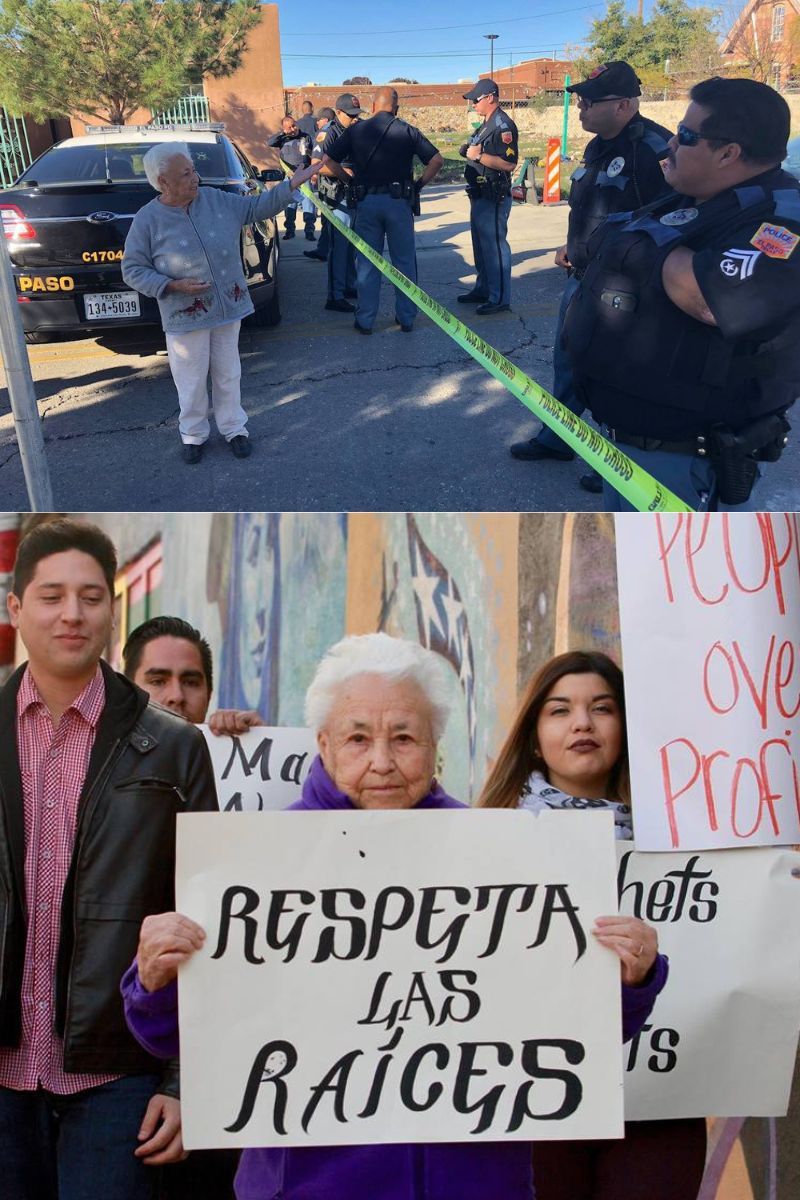
Toñita Morales, the 95-year-old sole renter remaining in Duranguito, faces off against El Paso Police Department Officers outside her home (top) and holds a sign saying “respect our roots” in Spanish during a protest (bottom). (Photos courtesy Paso del Sur)
Mendoza — the sole homeowner remaining here — remembers walking her sisters to the bus, passing through their neighborhood, seeing residents going to church and shopping at the now-extinct Tiradero Market, a flea market where locals sold their wares and connected with the community. She’s one of a few elderly Duranguito residents who has put up a fight as gentrification swept through her neighborhood, refusing to sell her home.
“Quiero ver que Duranguito florezca — I would like to see Duranguito flourish again,” she says in Spanish. “I would like to have more neighbors again. I would like to see something historic that portrays our fight and our history.”
The fight to save the area involved grassroots resistance, a lengthy legal battle that cost the city more than $3 million, and, ultimately, a change in local government that sympathized with the residents and the historical importance of Duranguito. In January, the city finally shut down the project that had long been at the mercy of the courts; it’s expected to announce a new location for the stadium in the coming days.
El Paso is not the only city that has dealt with a controversial proposal for a downtown sports stadium. As Philadelphia residents work to challenge a stadium that could threaten its own Chinatown, El Paso residents’ and preservationists’ efforts offer some insights into what it takes to move the needle.
“It was definitely an effort that was founded by the blood, sweat and tears of many, many people,” says El Paso County Commissioner David Stout.
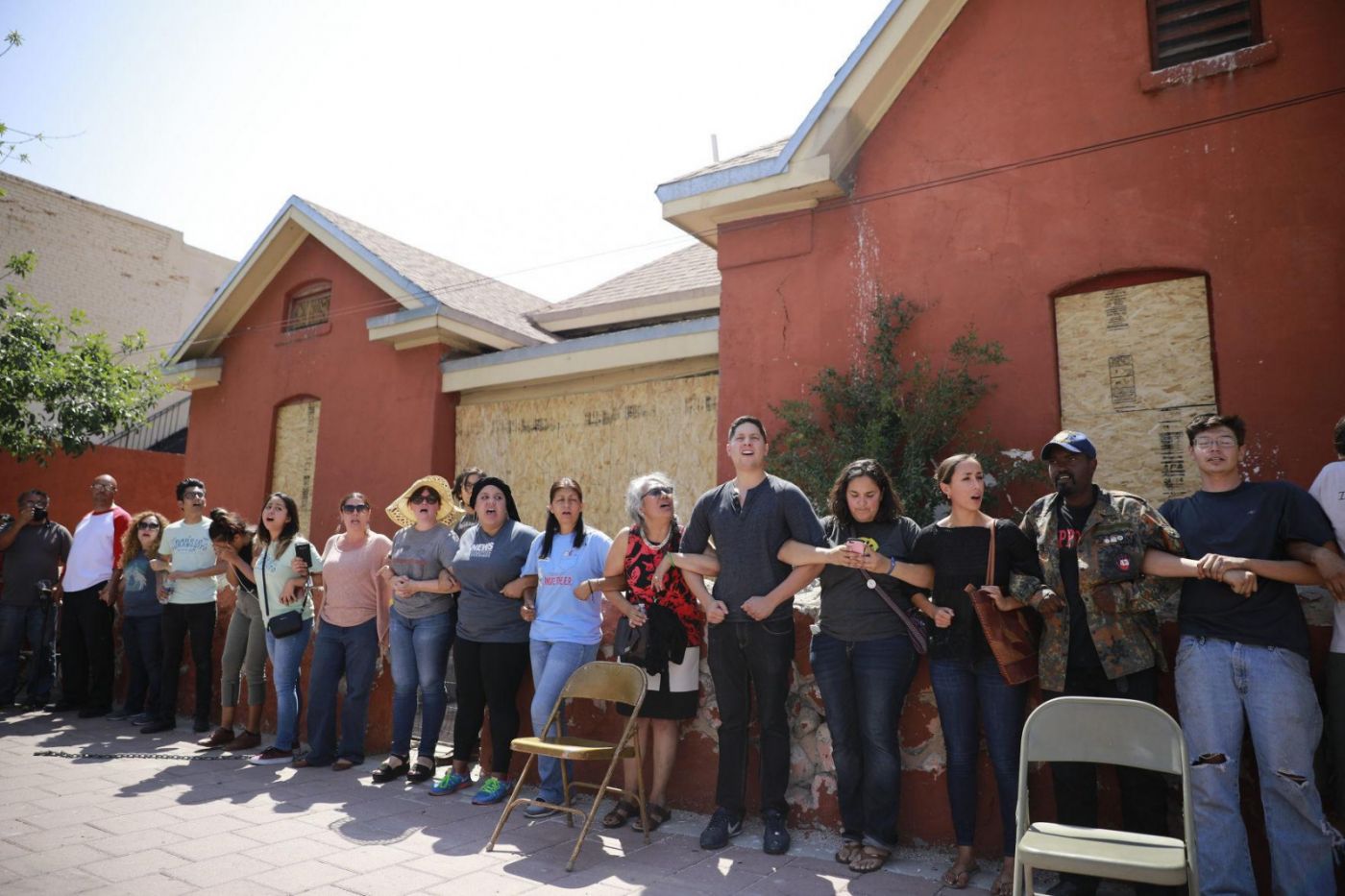
Protesters chained themselves to buildings and each other to protest the destruction of Duranguito. (Photo courtesy Paso del Sur)
Back in 2012, as part of a downtown revitalization plan, El Paso voters overwhelmingly approved a bond measure to build a $180 million multipurpose cultural arts and entertainment center in Downtown El Paso.
There was minimal movement on the bond project until four years later when the city issued a request for qualifications that described the center as “a mid-sized arena with a target capacity of 15,000 seats for basketball games.”
Chew, a history professor at the University of Texas at El Paso (UTEP), says the project’s handling was highly unethical, especially in its presentation to the public.
“Lanzaron el anzuelo y ya que pico, lo cambiaron,” she says in Spanish. “Once the hook was set, they changed it.”
A few months later, in October 2016, the city council abruptly voted to build the project in the Duranguito neighborhood, part of the Union Plaza district in Downtown El Paso. At the time city officials said the area had no historical designated buildings in the area hence the demolition could take place.
The move drew immediate community backlash. The location would have displaced about 60 low-income residents, mostly Latino seniors. Historic preservationists also maintained that some of the buildings in the proposed site, including The Mansion House, Pancho Villa’s Stashouse, and the Chinese Laundromat, had historic value and should not be demolished.
The council initially flip-flopped on scrapping the area after meeting privately with opponents but ultimately opted not to change the site.
About 47 residents of the area comprising 17 families were forced into moving, and those who stayed behind faced threats and intimidation to move out. Developers offered residents willing to move $10,000 to relocate and guaranteed housing for six months.
“It was how they were evicted, little by little, with threats of landlords refusing to fix things in the apartments,” says Chew.
Mendoza says that at first, she was terrified due to the constant harassment she and others in the area faced. She never entertained offers or had her house appraised. She says stubbornness helped her stay in her home.
“Yo hago lo que quiero como dicen los Mexicanos — I do what I want, like us Mexicans say,” she says in Spanish. “I’m not going to make a rich man richer. I worked very hard all my life as a seamstress just to survive.”
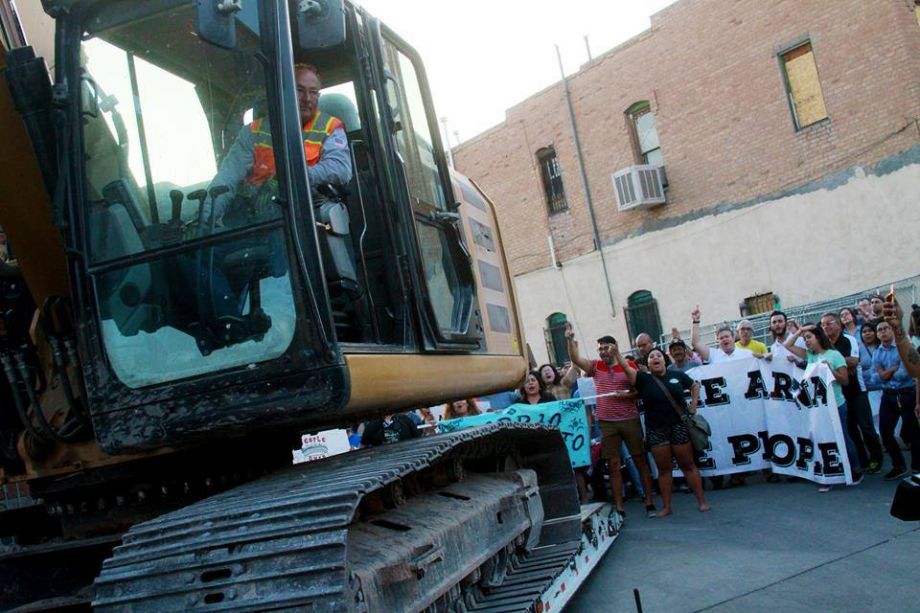
A bulldozer from the city of El Paso demolishes a historical building in Duranguito. (Photo courtesy Paso Del Sur)
When the city issued demolition permits in 2017, demolition crews hired by the then-owners of some of the properties damaged several of Duranguito’s buildings. Part of the sale agreements with the city required the property owner to raze the buildings and clear the site before the sale would be finalized.
The beginning of the demolition drew dozens of protestors to the area for a day-long standoff, during which some planned to tie themselves to the buildings. An emergency injunction was put in place to end the demolition, and the area was later fenced in. Still, the damaged buildings remained in a state of deterioration until the city stabilized them last fall.
Chew became involved in preserving downtown El Paso, specifically the historic Segundo Barrio, when she was a Ph.D. candidate. She later organized with fellow academics, hundreds of activists, students, former residents, religious groups of the area, legal teams, and city and county officials who joined the protest when the sites within Duranguito were set for demolition.
“Everyone played their part,” she says. “When someone got tired, others took their place. When the legal stuff was failing, the activists would jump in. When we would get hurt, the lawyers would go in.”
At the head of the activist front was the grassroots group Paso Del Sur, created in 2006 when Segundo Barrio was facing a significant redevelopment that would displace about 1,800 people, says Romo, a founding member.
Before Duranguito was announced as the future site of the arena, the group received leaked internal documents from sympathetic workers within El Paso’s municipal government showing that the historic neighborhood would be on the chopping block, inspiring a movement of local historians, artists, activists, and residents to rise against the arena.
The arena proposal had been announced on a Thursday; the item was approved the following Tuesday. Shortly after, bulldozers headed to the site to demolish the structures within. Romo, in conjunction with UTEP professor and Chicana historian Yolanda Chávez Leyva, organized a group to protest the demolition.
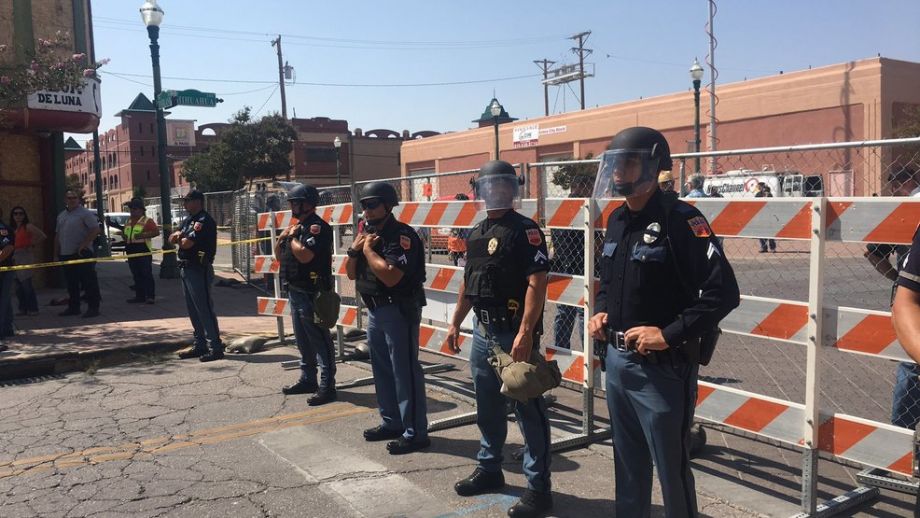
El Paso Police Department deployed officers wearing riot gear to a non-violent protest by activists defending Duranguito. (Photo courtesy Paso Del Sur)
Stout, the county commissioner, got involved with the fight for Duranguito at the same time.
“We jumped into action and started working together to keep the neighborhood from being razed,” he says. “We basically stood in front of the bulldozers to keep them from advancing.”
At this time, those protesting the demolition were fenced in and told that if they left, they would not be allowed back in.
“If we left, we knew that the buildings would be damaged further or more buildings would be damaged,” says Stout. “The police came with riot gear, which was completely uncalled for. Nobody was rioting. Nobody was being violent.”
A 2015 study by design firm HKS identified four possible sites for the arena project: behind the current City Hall building on Campbell Street; south of the convention center in Union Plaza, which encompasses the Duranguito neighborhood; north and south of Paisano Drive in the Chihuahuita neighborhood; and south of Interstate 10 near Kansas Street.
Romo and Leyva used their research skills to uncover the history of Duranguito and argue that “there’s a huge history of discrimination against based on race, class and age as well,” says Romo.
Their research — involving hundreds of historical documents that were themselves hundreds of years old — found an irrigation system that ran through the neighborhood and was linked to a Native American settlement dating back to the time of the Conquistadors.
“What saved us were the ghosts of the Apaches,” says Romo. “For me, as a historian, it was very gratifying to find documentary proof that shows that the Spaniards built the wooden bridge back in 1797. We located a crossing on this bridge where the Spaniards had an (Apache) reservation.”
These findings formed the basis for a lawsuit based on an obscure Texas antiquities law that required an archaeological survey of the area. That, in turn, jump-started a legal battle to save the neighborhood in 2017 when the city filed a bond validation suit in Austin. The trial court ruled that the city was not authorized to use quality-of-life bonds to build a sports arena, but an appeals court ultimately ruled in the city’s favor the following year.
The backlash from choosing the Duranguito neighborhood led to a six-year legal battle that bounced around Texas courts. It kept the project and arena site in limbo and cost taxpayers at least $3.3 million in legal fees. Three legal teams, including a pro se team composed of Leyva with Romo as his expert witness, a team from Legal-Aid, and UTEP art history professor Max Grossman’s team, faced the city in various lawsuits. Grossman, an architectural historian, and self-proclaimed “chief instigator” infamous in local politics, remained the sole legal group going against the city thanks to financing from Houston businessman J.P. Bryan. Two other teams faced off against the city in Travis County, eventually dropping their suits. Bryan is the former CEO of Torch Energy Advisors, a Texas-based, multimillion-dollar energy company. He is an honorary life board member of the Texas Historical Association and also serves as its executive director, which has caused controversy among board members. “(Bryan) has a deep and long interest in West Texas,” says Grossman. “He’s a guy who has conducted historic preservation projects across the state. He spends a portion of his fortune promoting these projects.” Grossman says he opposed the arena because of the use of eminent domain for entertainment purposes, the displacement of residents, the architectural importance of the structures, the inflated cost of the arena, and its overall impracticality. “My team found other ways to sue and other ways to delay,” Grossman says. “In the meantime, what we did was work on politics. I got deeply involved in politics and in City Council elections. I recognized pretty early that the legal process could only take us so far.” Grossman did not elaborate on the cost of the legal battle: “I feel it’s not anybody’s business.” This final lawsuit, which was dismissed in September, targeted the archeological permit issued by the Texas Historical Commission that would have allowed the city to raze the buildings on the site. On Oct. 24, the city completed the work to reopen Chihuahua Street, but the damaged buildings remain fenced to keep people from entering them. City of El Paso Spokeswoman Laura Cruz-Acosta said the appeal was dismissed because there was no longer a dispute over the validity of the permit since the property at Santa Fe and Overland is no longer the location of a multipurpose facility. “On Oct. 10, the city council directed city staff to begin soliciting and entertaining letters of interest for development/ownership in city-owned property within the former site for the Multipurpose Performing Arts and Entertainment Center,” she says. A new site for the arena has not been made public. In November 2021, the City Council directed staff to get a cost estimate for the stalled multi-million-dollar bond project and begin negotiations to resolve the legal battle over the site. The cost estimate was presented to city council on January 2023. This year, a slate of newly-elected council members made the next move to resurrect the long-stalled project. In January, the City Council voted to abandon the Duranguito neighborhood and look for other potential sites. The vote also included resolving the remaining litigation with Grossman. “The only way we were going to kill this thing was to get a majority on City Council,” says Grossman. “As soon as we got our new people into office, 15 minutes after they were sworn in, they immediately killed the arena.” Former City Councilwoman Alexsandra Annello was elected as the site for the arena was announced. She opposed the narrative that Duranguito was a crime-plagued area that wasn’t worth saving and whose residents would be better off in public housing. She recently resigned to seek a higher office in the state legislature. One of the five buildings that were damaged while the city of El Paso attempted to raze buildings in Duranguito. (Photo courtesy Paso Del Sur) This view was based on “a lot of classism and bad rhetoric that was unfair to these communities who have built their entire lives here,” she says. “If there’s crime … the government should step in to help them, not remove (the residents) and make money off the area.” The City Council’s eventual change in leadership, with public officials sympathetic to the cause, is a prime example of how “activism can change the tide,” says Stout. “I’m so glad that the folks who were opposing this are no longer in office trying to do more damage to this community.” Securing the win took being able to cross party lines and working with other organizations, Grossman says. “I’ve worked with Paso del Sur, people on the right, Republicans, and libertarians,” says Grossman. Without Bryan’s deep pockets and the new city councilmembers, the neighborhood would be gone, he notes. “I will also say that on September 11, 2017, when activists jumped on top of the bulldozers, that, too, was a very critical moment because my attorneys might not have been able to save it in time.” Just as important was the simple strategy “to delay legally, make it very difficult for the city so they could not do anything,” he says. “We just kept them stuck until we could overcome them politically and win those elections and then kill it. And that is exactly what we did. It took six and a half years.” The city is now looking at alternate sites for the arena, including Sun Metro properties it owns in Downtown El Paso. With the City Council apparently on his side, Grossman said he would not oppose building the arena in El Paso. “They’re going to build it within budget,” he says. “They’re going to build it in a place that does not displace anybody and does not demolish anything historic.” Most of the buildings still in Duranguito are now owned by the city, which voted during an October council meeting to sell them. “One of the options given to us was to just put them up for sale and get the highest bid,” Annello says. “That defeats the entire purpose. We want to know what people want to do in this area. We want to know how we can rebuild this community.” Renderings of a plan by Paso Del Sur Group imagining what Duranguito could become. (Images courtesy Paso Del Sur) Paso Del Sur has created a community-led plan for Duranguito that includes affordable housing, a cultural center, a community garden, museums and a health center. The project plays on the Japanese concept of kintsugi — where gold is used to reattach broken things to highlight the value of their imperfections — to preserve the neighborhood’s dilapidated buildings. The plan has not been funded, but a new nonprofit called Project Regeneracíon was created over the summer to find investors and turn the concept from the poster boards Romo carries in his car into a reality. Paso Del Sur has also asked the county to consider purchasing the buildings. “We’re asking that there’ll be a conscious and deliberate choice not to gentrify to make sure that we repair as much as possible that close-knit community,” Romo says. “This vision is based on a combination of residential and social services, promoting the site for visitors from other parts of the United States or even Mexico, but also promoting it for the people from El Paso.” Romo says there is a sense of urgency to establish a plan for Duranguito while there is an amicable government in office. Current mayor Oscar Leeser and four city representatives are up for reelection in November 2024. New members would take office the following January. Grossman imagines a mixed-use neighborhood with privately owned businesses and federally subsidized housing in Duranguito to “bring some people back into the barrio to recover its character,” he says. “I imagine cafes and bars done tastefully. I just want the character of the buildings to be retained. No demolition, no more displacement.” Displacement, however, has already swept through the neighborhood. Only two residents remain in the area: Mendoza and Toñita Morales, who is known as “the grandmother of the barrio.” Morales, who is in her 90s, moved to the neighborhood in 1965 and continues to rent in the area. “I’m very sorry about the displacement and that five buildings were damaged by a bulldozer, ” says Grossman. “But I think the result that has happened right now is the best possible result.” For his part, Stout says he does not oppose building an arena in El Paso. His objection was to doing so in one of the city’s most historic neighborhoods, which “represent many different epochs in cultures that have made what El Paso is today. It’s a microcosm of what our community is and who built it.” As a county commissioner, Stout is working on ways to partner with the city and seek private partnerships to bring the neighborhood back to life. “I think any type of progress moving forward needs to be a community-driven project from the bottom up, not from the top down,” he says. El Paso Matters Reporter Elida S. Perez contributed to this report. Next City is one of more than 25 news organizations powering the Philadelphia Journalism Collaborative. We do solutions reporting on things that affect daily life in our city where the problem and symptoms are obvious, but what’s driving them isn’t. Follow us at @PHLJournoCollab.Change in government
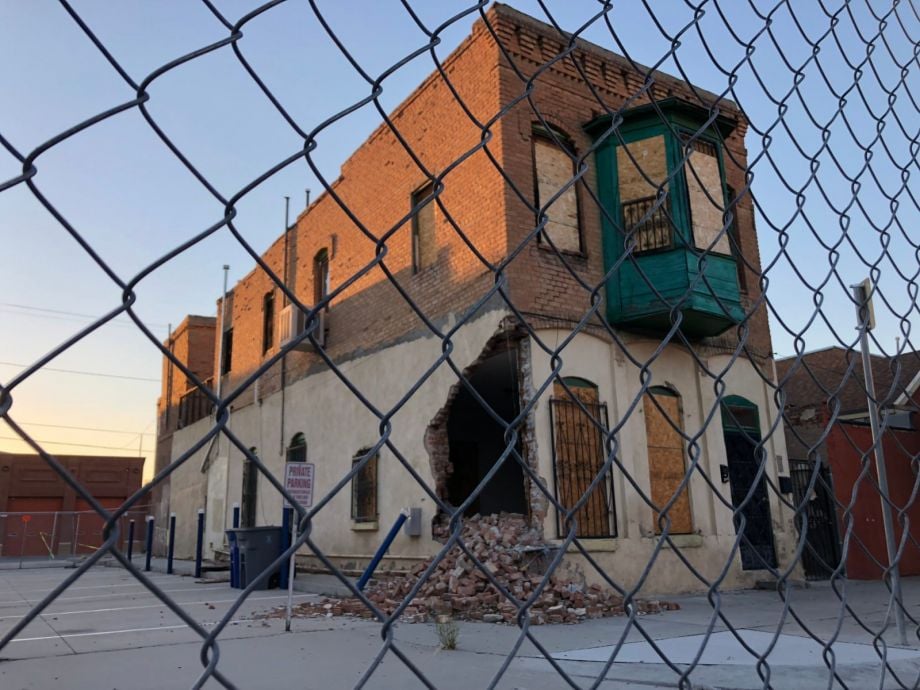
New visions for Duranguito
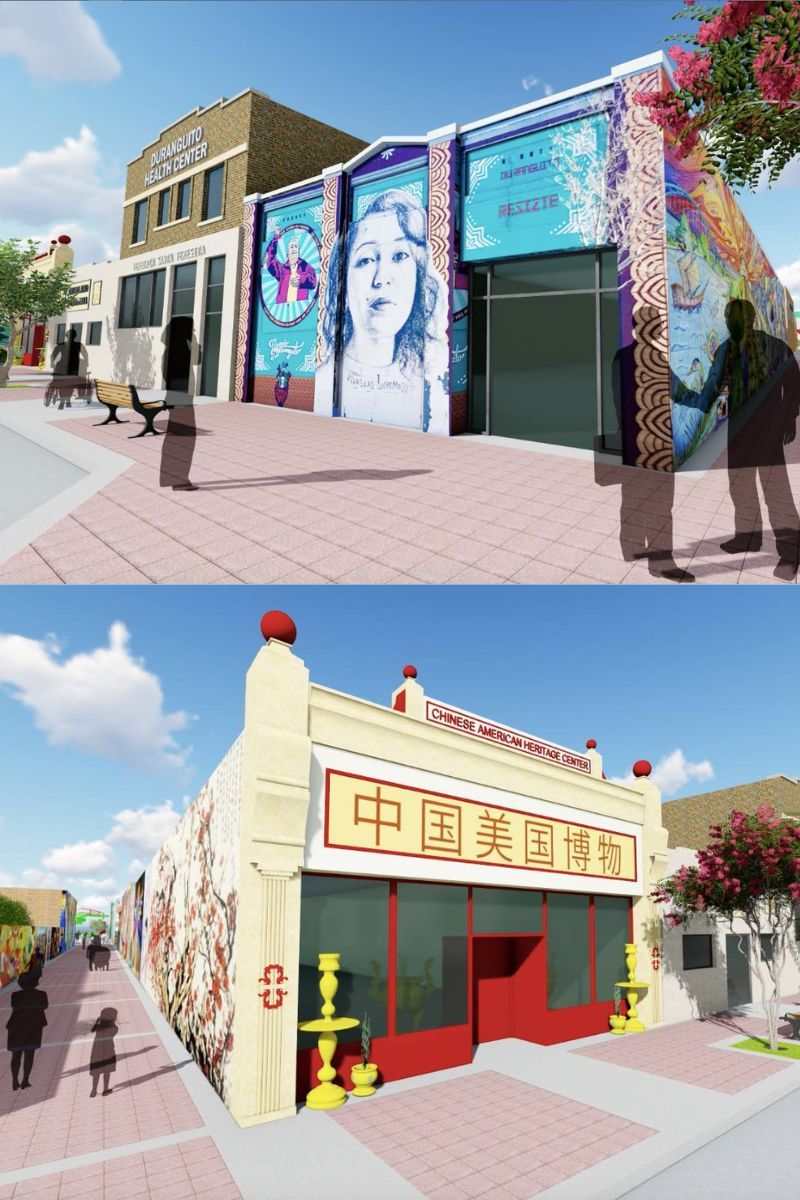

Christian De Jesus Betancourt is Next City and El Paso Matters' joint Equitable Cities Reporting Fellow for Borderland Narratives. He has been a local news reporter since 2012, having worked at the Temple Daily Telegram, Duncan Banner, Lovington Leader and Hobbs News-Sun. He's also worked as a freelance reporter, photographer, restaurant owner and chef. Born and raised in Juarez, El Paso became Betancourt’s home when he moved there in the seventh grade.

20th Anniversary Solutions of the Year magazine